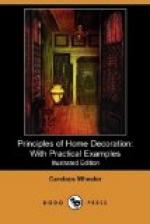This may be called corrective treatment of a room, and may, of course, include all the decorative devices of ornament, design and furniture, and although it is not, strictly speaking, decoration, it should certainly and always precede decoration.
It is sad to see an elaborate scheme of ornament based upon bad colour-treatment, and unfortunately this not infrequently happens.
It is difficult to give a formula for the decoration of any room in relation to its colour-treatment, except by a careful description of certain successful examples, each one of which illustrates principles that may be of use to the amateur or student of the art.
One which occurs to me in this immediate connection is a dining-room in an apartment house, where this room alone is absolutely without what may be called exterior light. Its two windows open upon a well, the brick wall of which is scarcely ten feet away. Fortunately, it makes a part of the home of a much travelled and exceedingly cultivated pair of beings, the business of one being to create beauty in the way of pictures and the other of statues, so perhaps it is less than a wonder that this square, unattractive well-room should have blossomed under their hands into a dining-room perfect in colour, style, and fittings. I shall give only the result, the process being capable of infinite small variations.
At present it is a room sixteen feet square, one side of which is occupied by two nearly square windows. The wood-work, including a five-foot wainscot of small square panels, is painted a glittering varnished white which is warm in tone, but not creamy. The upper halves of the square windows are of semi-opaque yellow glass, veined and variable, but clear enough everywhere to admit a stained yellow light. Below these, thin yellow silk curtains cross each other, so that the whole window-space radiates yellow light. If we reflect that the colour of sunlight is yellow, we shall be able to see both the philosophy and the result of this treatment.
The wall above the wainscot is covered with a plain unbleached muslin, stencilled at the top in a repeating design of faint yellow tile-like squares which fade gradually into white at a foot below the ceiling. At intervals along the wall are water-colours of flat Holland meadows, or blue canals, balanced on either side by a blue delft plate, and in a corner near the window is a veritable blue porcelain stove, which once faintly warmed some far-off German interior. The floor is polished oak, as are the table and chairs. I purposely leave out all the accessories and devices of brass and silver, the quaint brass-framed mirrors, the ivy-encircled windows, the one or two great ferns, the choice blue table-furniture:—because these are personal and should neither be imitated or reduced to rules.
The lesson is in the use of yellow and white, accented with touches of blue, which converts a dark and perfectly cheerless room into a glitter of light and warmth.




